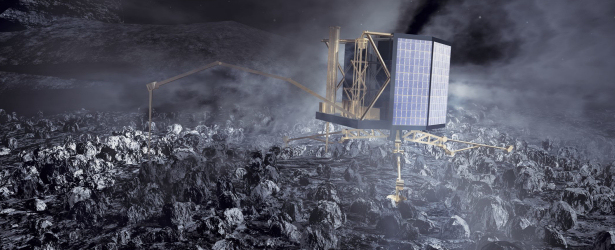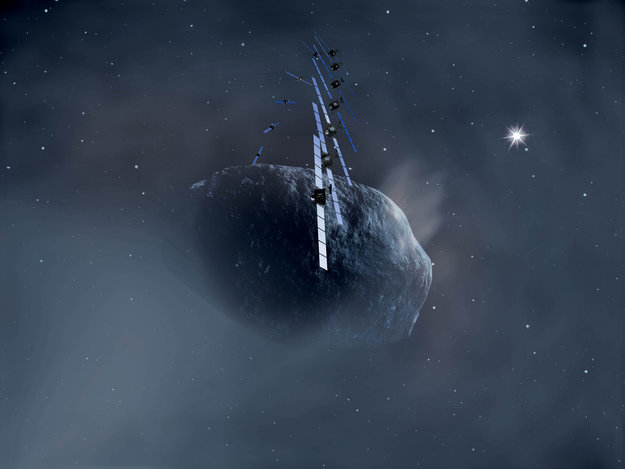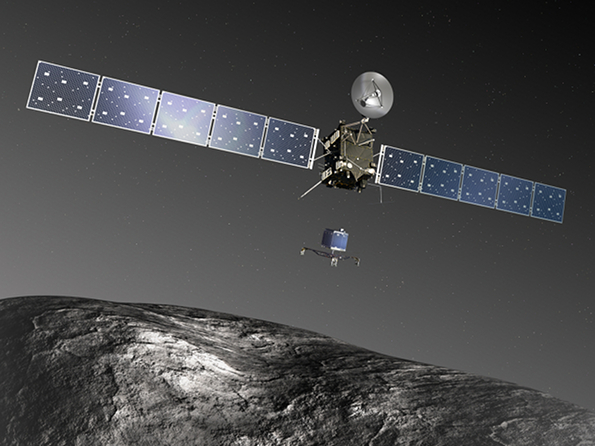Comet-hunting probe Rosetta about to wake up, zero in and land on a comet

This month, after 10 years of traveling through our solar system, the first space mission designed to study and deliver a lander on a comet is up for a major milestone.
Launched by European Space Agency (ESA) back in 2004, the unique comet-hunter spacecraft "Rosetta" is expected to wake up from its deep-space hibernation mode on January 20 and position itself for a historical rendezvous with Comet 67P/Churyumov-Gerasimenko.
Rosetta's internal alarm clock is set for 10:00 UTC, and once it wakes up, it will first warm up its navigation instruments and spin down to point its main antenna at Earth, to let the ground team know it is still alive.

Rosetta gets its name from the famous Rosetta stone that led to the deciphering of Egyptian hieroglyphics almost 200 years ago. Similarly, scientists hope that Rosetta will unlock the mysteries of how the Solar System evolved.
"We don't know exactly at what time Rosetta will make first contact with Earth, but we don't expect it to be before about 17:45 UTC on the same day," Fred Jansen, ESA's Rosetta mission manager said.
"We are very excited to have this important milestone in sight, but we will be anxious to assess the health of the spacecraft after Rosetta has spent nearly 10 years in space."


An artist’s impression of Rosetta orbiting Comet 67P/Churyumov-Gerasimenko. Image copyright ESA/AOES Medialab
After wake-up, Rosetta will still be about 9 million km from the comet. As it moves closer, the 11 instruments on the orbiter and 10 on the lander will be recommissioned.
The first images of a distant 67P/Churyumov-Gerasimenko are expected in May 2014, which will dramatically improve calculations of the comet's position and orbit.
In early May, Rosetta will be 2 million km from its target, and towards the end of May it will execute a major maneuver to line up for the rendezvous.
Closer in, Rosetta will take thousands of images that will provide further details of the comet's major landmarks, its rotation speed and spin axis orientation. It will also make important measurements of the comet's gravity, mass and shape, and will make an initial assessment of its gaseous, dust-laden atmosphere, or coma.
Rosetta will rendezvous with Comet 67P/Churyumov-Gerasimenko in August 2014 and remain in its close proximity. After extensive mapping of the comet's surface during August and September, a landing site for the mission's 100 kg Philae probe will be chosen.
This will be the first time that landing on a comet has ever been attempted.
Given the almost negligible gravity of the comet's 4 km-wide nucleus, Philae will 'dock' with it using ice screws and harpoons to stop it from rebounding back into space. The landing is expected in November 2014.
Philae will send back a panorama of its surroundings and very high-resolution pictures of the surface and will perform on-the-spot analysis of the composition of the ices and organic material. A drill will take samples from 20–30 cm below the surface, feeding them to Philae's laboratory for analysis.
The comet will reach its closest distance to the Sun on August 13, 2015 at about 185 million km, roughly between the orbits of Earth and Mars.
As the comet hurtles through the inner Solar System at around 100 000 km/h, the relative speed between orbiter and comet will remain equivalent to walking pace. During this 'escort' phase the orbiter will continue to analyze dust and gas samples while monitoring the ever-changing conditions on the surface as the comet warms up and its ices sublimate.
By December 2015, both the spacecraft and the comet will have circled the Sun and be on their way out of the inner Solar System.


Rosetta was launched on March 2, 2004, and through a complex series of flybys – three times past Earth and once past Mars – set course to its destination: comet 67P/Churyumov-Gerasimenko. It also flew by and imaged two asteroids, Steins on September 5, 2008 and Lutetia on July 10, 2010.
In July 2011 the spacecraft was put into deep-space hibernation for the coldest, most distant leg of the journey as it travelled some 800 million kilometres from the Sun, close to the orbit of Jupiter. The spacecraft was oriented so that its solar wings were facing the Sun to receive as much sunlight as possible, and it was placed into a slow spin to maintain stability.
Its mission objective is to study the origin of comets, the relationship between cometary and interstellar material, and its implications with regard to the origin of the Solar System. The measurements to be made to achieve this are:
- Global characterization of the nucleus, determination of dynamic properties, surface morphology and composition;
- Determination of the chemical, mineralogical and isotopic compositions of volatiles and refractories in a cometary nucleus;
- Determination of the physical properties and interrelation of volatiles and refractories in a cometary nucleus;
- Study of the development of cometary activity and the processes in the surface layer of the nucleus and the inner coma (dust/gas interaction);
- Global characterization of asteroids, including determination of dynamic properties, surface morphology and composition.


Artist's impression of Rosetta and Philae at the comet. Credit: ESA – C. Carreau/ATG medialab
The total cost of the mission is close to 1 thousand million Euro. This includes the launch, the spacecraft, the science payload (instruments and lander) and mission and science operations. The delay of the launch contributed about 70 million Euro to the cost.
Source: ESA
Learn more:
Featured image: The Philae lander at work on Comet 67P/Churyumov-Gerasimenko. While Rosetta studies the comet from close orbit, Philae will obtain measurements from the surface.
Immediately after touchdown in November 2014, a harpoon will be fired to anchor the lander and prevent it from escaping the comet’s extremely weak gravity. The minimum targeted mission time for Philae is one week, but surface operations may continue for many months. The measurements from the Rosetta orbiter will last from August 2014 to the end of 2015. Copyright: ESA / AOES Medialab

Commenting rules and guidelines
We value the thoughts and opinions of our readers and welcome healthy discussions on our website. In order to maintain a respectful and positive community, we ask that all commenters follow these rules:
We reserve the right to remove any comments that violate these rules. By commenting on our website, you agree to abide by these guidelines. Thank you for helping to create a positive and welcoming environment for all.